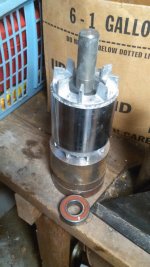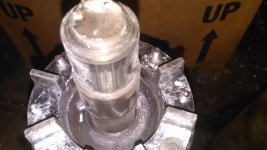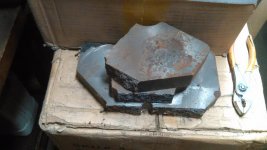ignator
Cast Iron
- Joined
- Oct 8, 2012
- Location
- Marion, Iowa
This motor was on my lathe as a replacement I did from single to 3phase. I removed the rotor to cut the key shaft down to the original pulley of the lathe. It was 7/8", and I reduced it to 5/8". Do to shock and cantilever of pulley position on shaft, this failed. The shaft snapped off.
So the task is to press out the broken motor shaft from the rotor steel laminations, and make a new one.
I assumed the shaft was pressed in. So I made a press jig to protect the aluminum cast fins, which are part of the squirrel cage electrical shorting bars (I think that's what they are called). The shaft will not budge on a 20 ton press. Motor size is 1HP, and special inverter duty winding insulation. In fact the cast iron bucking plates that came with the press, failed catastrophically (the plate), and allowed the rotor and pressing jig to explosively shoot into the sheet rock wall.
Is there a reason this can not be pressed out?
Also is there a recommended steel for the shaft? It was very soft to machine (Rc 5 or so), so appears to have zero heat treat or hardened alloy qualities. I don't believe that the material is some sort of eddy current blocking metal. The shaft can only be pressed out one way, as one end has a raised section for the bearing that is larger diameter then the shaft section that goes through the laminations.





I'm thinking the only way to remove this is to cut it off, and drill it out, then bore to clean it up, and make a shaft that will press fit properly.
It just seems this should have budged from the laminant stackup.
So the task is to press out the broken motor shaft from the rotor steel laminations, and make a new one.
I assumed the shaft was pressed in. So I made a press jig to protect the aluminum cast fins, which are part of the squirrel cage electrical shorting bars (I think that's what they are called). The shaft will not budge on a 20 ton press. Motor size is 1HP, and special inverter duty winding insulation. In fact the cast iron bucking plates that came with the press, failed catastrophically (the plate), and allowed the rotor and pressing jig to explosively shoot into the sheet rock wall.
Is there a reason this can not be pressed out?
Also is there a recommended steel for the shaft? It was very soft to machine (Rc 5 or so), so appears to have zero heat treat or hardened alloy qualities. I don't believe that the material is some sort of eddy current blocking metal. The shaft can only be pressed out one way, as one end has a raised section for the bearing that is larger diameter then the shaft section that goes through the laminations.





I'm thinking the only way to remove this is to cut it off, and drill it out, then bore to clean it up, and make a shaft that will press fit properly.
It just seems this should have budged from the laminant stackup.

